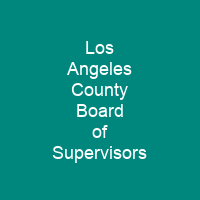The Board of Supervisors consists entirely of women for the first time in the board’s history. In March 2002, Los Angeles County voters passed Measure B to limit the supervisors to three consecutive four-year terms. The CEO has returned to a facilitation and coordination role between departments.
About Los Angeles County Board of Supervisors in brief

Until recently, the chief executive officer was the appointed individual heading the county but had little power as supervisors retained the right to fire and hire department heads and often directly admonished department heads in public. The Chief Executive Officer, the Chief Counsel and the Executive Officer attend each Board meeting, or their deputies attend each meeting, legally required for the purpose of conducting public hearings, and have their agenda items continued from a previous meeting. All items are automatically approved without discussion, unless a Supervisor or member of the public requests a specific item be continued from the previous meeting, unless the Supervisor or public member requests it be continued. The chair of the Board ofSupervisors serves a term of one year. Upon expiration of the term the duties of the chair are rotated among the board members by order of seniority. Supervisors must reside and be voters in the district they represent. Elections for the 1st and 3rd districts coincide with California’s gubernatorial elections, while those for the 2nd, 4th and 5th District coincide with the United States presidential election.
You want to know more about Los Angeles County Board of Supervisors?
This page is based on the article Los Angeles County Board of Supervisors published in Wikipedia (as of Dec. 02, 2020) and was automatically summarized using artificial intelligence.







